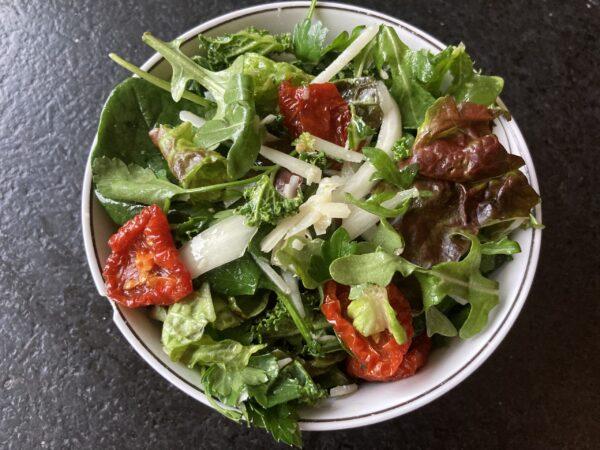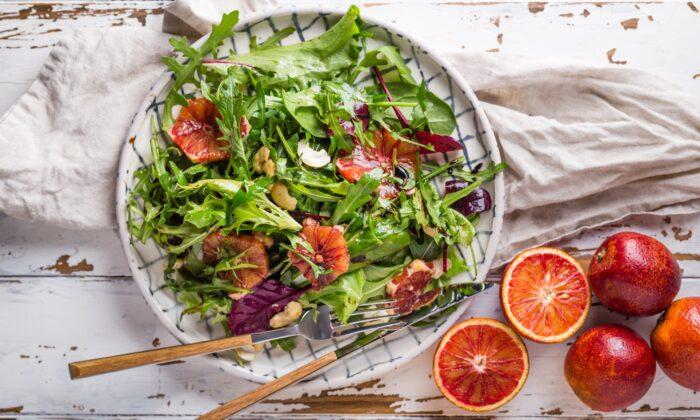The farmers market used to be more of a summertime thing. When the landscape turns brown and white, our thoughts don’t rush off to the next farmers market.
But don’t sleep on—or through—the winter market. The colors of fresh veggies seem all the more vibrant against the grim backdrop of winter, and the flavors are like much-needed tastes of sunshine.

I live in Montana, which is about as close to Canada as you can get without a passport, and even there the diversity of produce at the winter market is astounding. Here and now in the middle of a Montana winter, I just ate a glorious salad of local greens that looks like it came straight out of July.
We owe this winter bounty to a perfect storm of changes. Warmer temperatures have tilted the growing field toward winter growth, furthered by advances in greenhouse technology, and funded by increasing hunger for local food, which makes it increasingly worthwhile for farmers to pay for heat—in return for year-round profits.
Northern farmers have been inching in this direction for years. Before it became common to pay to heat their greenhouses, farmers were extending their growing seasons with tricks like building little hoop houses inside big greenhouses, and covering these greenhouse crops for extra warmth. Back then, if a farmer heated a greenhouse, it was usually to start finicky plants like tomatoes, cucumbers, and peppers in order to give them enough of a head start that they would bear fruit.
It was about two years ago that I noticed a sharp increase in the winter market greenery. The daring farmer had no trouble selling her tender greens. I noticed the other growers taking notice of her success, and the idea spread like weeds.
Today, the winter greenhouse bounty at the mid-January market includes arugula, bok choy, broccoli, lettuce, kale, parsley, cilantro, and celery. The usual winter storage crops are for sale, too, as well as protein-rich foods such as dried beans, cheese, eggs, beef, pork, chicken, and even local saltwater shrimp from a guy who grows them in a tank. And there are baked goods and condiments and value-added delicacies such as maple syrup, hot sauce, dried tomatoes, and other fruit.
With raw ingredients such as these, we have many options for making a satisfying winter meal. I like to make a hearty winter-style stew with meat, potatoes, carrots, celery, and onions, and serve it with as many raw garnishes as possible, such as chopped raw onion and fresh parsley or cilantro.
Another way to enjoy this bounty is to add winter greens to potato salad. Along with shredded carrots, hard-boiled eggs, garlic, and onions, add kale, parsley, and whatever else you can score that makes sense.
Alternatively, make a grain salad, with cooked wheat or quinoa and additions of chopped parsley, garlic, onions, and cheese, all tossed in a tangy vinaigrette.
Those recipe ideas all lead to a satisfying, hearty place. But now that winter is the new summer, why not go with a straight green salad? The only thing glaringly absent from a bowl of winter greens would be the luscious tomatoes of summer. We make dehydrated tomatoes at home, in the peak of summer when fresh tomatoes are cheapest. In a salad, these dried tomatoes offer a similar sweet tang to the summer version, but with less juice.
The farmers markets of summer get all the glory, but pound for pound, the winter markets have more guts. These off-season centers of homegrown commerce, which run from about Halloween through Easter, are like the distilled essence of their summer counterparts, smaller but more potent. Cuter, too, with more hot cocoa.
Here’s a recipe for a tangy dressing that goes great on fresh greens, and is easily customized into enough different variations to dress any salad.

Tangy Winter Salad
The first time I made this salad, I ravaged it like it was steak drenched with wine sauce, and I had just come home from war. The dressing recipe comes from SweetPeasAndSaffron.com, and includes several variations, which I will note below.I’m hesitant to give a specific ingredient list, because your instructions are simply to go get greens at the winter market and build a salad around them, dressed with one of the variations on the dressing, along with onions, cheese, and garlic, which you can reliably find at most winter markets.
You probably won’t have access to the exact same array of leaves that I got last week. It doesn’t matter. Get what you can. But for the sake of education, here is what I used. (I’ll leave the quantities flexible, too; it’s a salad, not a croissant.)
Servings will vary.
- 1/2 cup white wine vinegar
- 1/2 cup extra-virgin olive oil
- 1 teaspoon Dijon mustard
- 1 tablespoon maple syrup
- Salt and pepper to taste (don’t skimp on the salt)
- Greens (I used curly kale, red leaf lettuce, baby spinach, arugula, and parsley)
- Sliced onions
- Dehydrated tomatoes, if you got ‘em
- Pressed garlic
- Hard cheese like Romano, grated; or crumbled feta
Remove the ribs from the kale leaves. Massage the remaining foliage by squeezing and mashing it between your hands. Rip or cut it down to bite-size pieces. Chop the lettuce and parsley as well. Leave the arugula and baby spinach whole.
Variations on the Dressing
Asian variation: Add some toasted sesame oil.Chile lime variation: Add some chile powder, garlic, and lime juice.
Fajita sauce variation: Add chile powder, paprika, cumin, and lime juice.
Zesty lemon version: Add lemon juice and zest.





